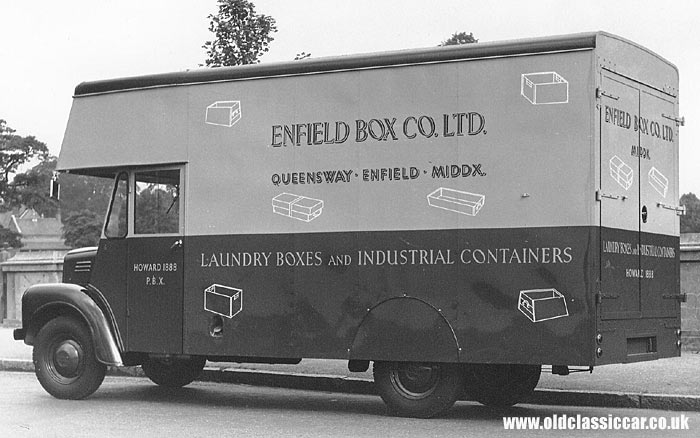1. Trojan delivery lorry.
Les F has delved into his archives once more, and turned up this interesting shot of a 1950s' Trojan lorry, featuring signwriting for the Enfield Box Company Ltd. of Middlesex. He suspects that it is a 2 ton Trojan lorry, as it only has single rear wheels fitted. The Trojan is fitted with Luton-style bodywork similar to that often seen on removal vans, extending over the top of the cab for increased carrying capacity. This one looks to have been supplied as a rolling chassis, fitted with factory front panelwork only, and delivered to an unknown coachbuilding firm who built the main body, cab and doors.
|

|
|
Although not often seen today, Trojan cars, vans and small lorries were common sights on Britain's roads, their vehicles often featuring distinctive styling and quirky designs, so they often stood out from the crowd. In later years they even entered the bubble car market by assembling Heinkel bubble cars built under licence.
|
|
The firm started out producing small & economical four cylinder two-stroke motor-cars, short on creature comforts and designed with frugality very much in mind. They would go on sale in the early 1920s, yet were designed some years earlier, wartime munitions work getting in the way of automobile production at that time. From 1924, 5cwt (later 7cwt) van versions of the tiny car were offered and sold well to small-business owners across the land. These small vans, built at Leyland's factory in Kingston Upon Hull, had chassis-less construction, solid tyres, and a 10hp engine connected to the rear wheels via a two-speed epicyclic gearbox and chain drive. At the height of their popularity, some 85 examples of the 5cwt van were being produced every week.
|
|
In 1930 a 10cwt van would go on sale, commercial Trojan production now undertaken at Trojan's own factory in Purley since 1928. Operators large and small recognised the usefulness of the Trojan light commercials, with Brooke Bond Tea being a significant operator. In 1947 a new range of vans went on sale, available with either a two stroke engine, or a Perkins diesel unit, and continued in production until 1959.
|
2. Pre-war Trojans outside an old garage.
Next, a cracking post-war photograph of three 1930s Trojan vans parked outside Workman, Reed & Co. Ltd. The livery on the side of one van confirms that Workman Reed were located at the Beacon Works, Hewish, nr Bristol. The tax disc and "C" commercial operators licence can just be seen, attached to the van's scuttle. That van's registration isn't visible, but in the centre is a similar vehicle (fleet no. 16) registration FLC 603, a series introduced in November 1938. And just visible to the right, another Trojan van, this one registered as CBY xxx, a November 1936-onwards issue, all allocated to the Croydon/London area. A photo of an early three-door tourer can be found here.
|
|
However despite these vans quite possibly being pre-war, the Austin to the left confirms this as an early post-war photograph. The GYB series came out in January of 1945 in Somerset. The car alongside though is definitely pre-war, a 1935/1936 Ford Model CX, registered in the Bristol area, so quite local to this scene. Just to its right, a Shell petrol pump and globe.
|
| (Please click the thumbnail to view full-size image.) |
|
|
|
The building too is of great interest, adorned as it is in various signs relating to Petter Oil Engines, Morrison Farmlight Plant, and Fielding. Workman Reed & Co. were also sole concessionaires for Associated British Oil Engines in the West of England.
|
|
Return to Old Car Photos Page No. 9.
|






